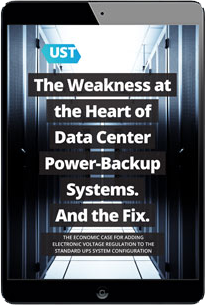 This article was first published as a white paper by UST in May 2014 under the title, “The Weakness at the Heart of Data Center Power-Backup Systems. And the Fix.” The PDF can be downloaded here.
This article was first published as a white paper by UST in May 2014 under the title, “The Weakness at the Heart of Data Center Power-Backup Systems. And the Fix.” The PDF can be downloaded here.
Uninterruptible Power Supply (UPS) systems in data centers are designed to do double duty – supply backup power in the event of a blackout, and continuously monitor and condition power in the event of other voltage irregularities. This legacy design is electrically inefficient, costing the average data center more than $130,000 in unnecessary utility charges annually. [1] However, efforts to introduce ‘green’ or ‘eco-mode’ options, despite the promise of significant cost savings, have been rejected by facility managers who believe they are making a safe choice by sticking to a standard configuration.
Unfortunately, the standard configuration contains a basic design weakness that all but guarantees one or more costly unplanned outages over the typical 10-year lifespan of an installation. This white paper examines the costs and the risks of the legacy UPS configuration and recommends consideration of an alternate system design that includes a modern automatic or electronic voltage regulator (EVR) as a standard component.
We estimate the combined cost of electrical inefficiency plus preventable unplanned outages at a 500kVA data center (used in this paper’s calculations) due to legacy UPS system design at $371,000 over 10 years. At an average U.S. data center, that cost will exceed $1,800,000.

